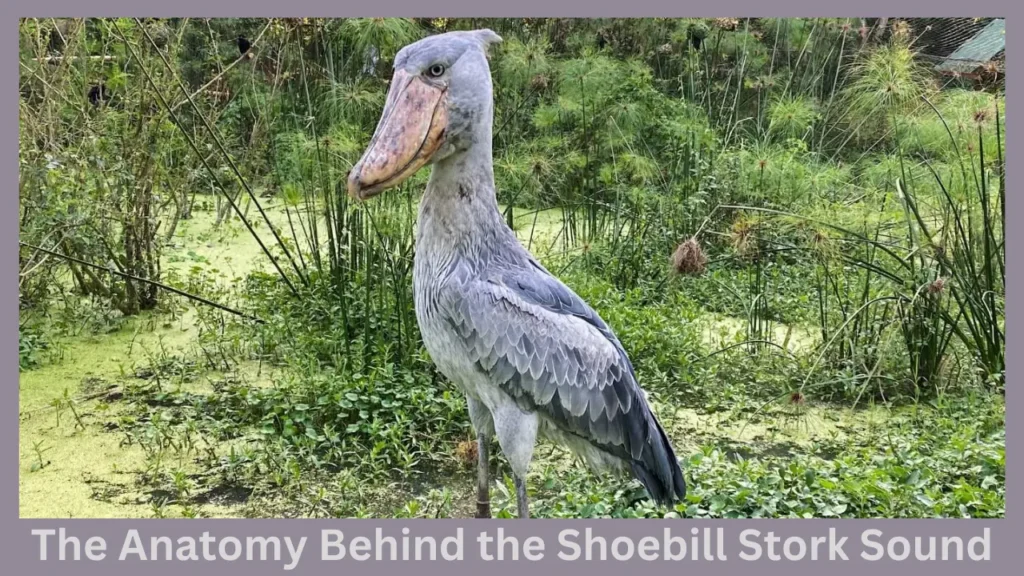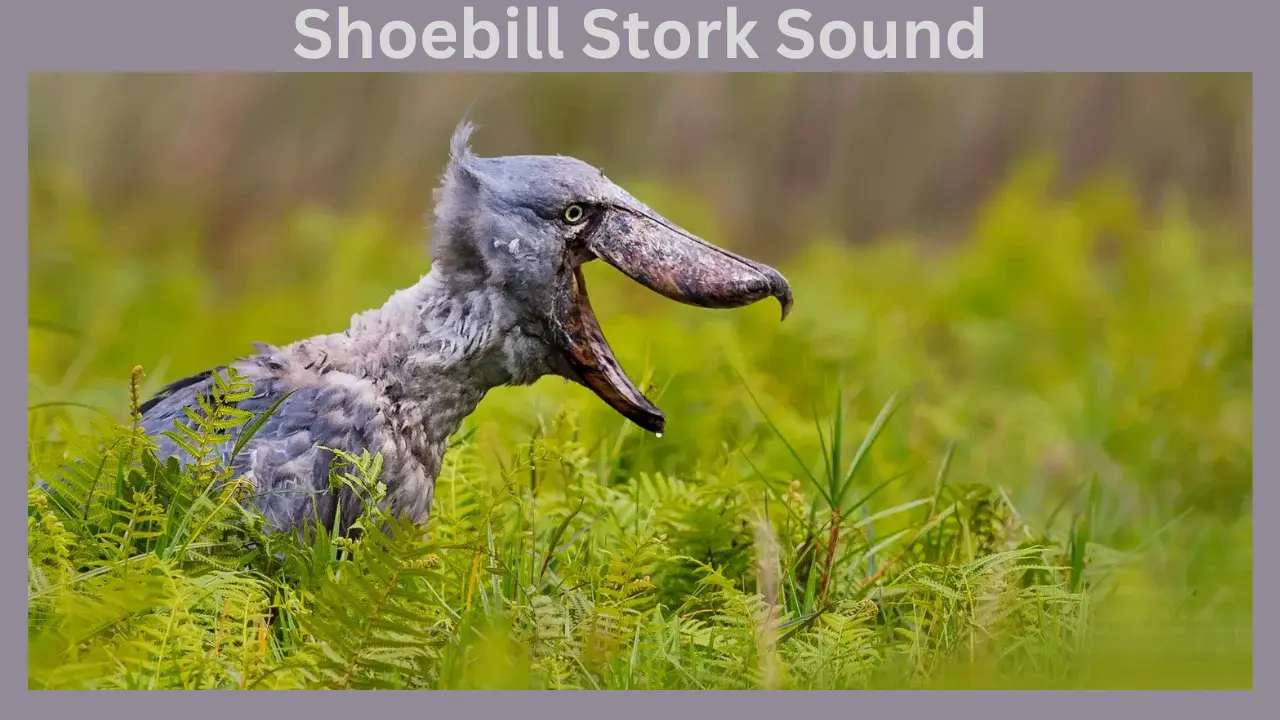The shoebill stork sound, known for its striking appearance, also captivates with its distinctive sound. This article delves into the fascinating world of the shoebill stork’s vocalizations, exploring their characteristics, purposes, and the role they play in the bird’s behavior.
Exploring the Shoebill Stork
Before exploring the shoebill stork sound, it’s essential to understand the bird itself. Native to the swamps and wetlands of East Africa, the shoebill stork (Balaeniceps rex) is a large, prehistoric-looking bird. Its most notable feature is its massive, shoe-shaped bill, which gives the bird its name. This bill is not only a formidable tool for hunting but also plays a role in the bird’s unique vocalizations.
ALSO READ: Amazon Drop Off 2777 North Stemmons Freeway S 75235
Physical Characteristics
Shoebill storks can grow up to 5 feet tall, with a wingspan that stretches up to 8 feet. Their enormous bills, measuring around 9 inches in length, help them catch large prey such as fish, frogs, and even small reptiles. Their slate-grey plumage and piercing yellow eyes contribute to their striking and somewhat intimidating appearance.
Habitat and Distribution
Shoebill storks inhabit freshwater swamps and wetlands in countries such as Uganda, South Sudan, and Zambia. These birds prefer isolated, dense vegetation areas where they can hunt efficiently. The remoteness of their habitat makes studying them challenging, adding to their mysterious nature.
The Unique Shoebill Stork Sound
Unlike many birds that produce melodious songs, the shoebill stork’s sound is distinctive and somewhat unexpected. The primary vocalization associated with this bird is a loud, clattering noise, often compared to the sound of a machine gun. This sound is produced by rapidly clapping their upper and lower mandibles together, a behavior known as “bill clattering.”
Bill Clattering: The Signature Sound
Bill clattering serves multiple purposes in the shoebill stork’s life. One primary function is during nesting, where both males and females engage in this behavior to communicate with each other and their chicks. The sound helps in strengthening pair bonds and coordinating parental duties.
Additionally, shoebill storks use bill clattering as a territorial display. The loud noise can deter potential intruders and signal the presence of an established pair in the area. This auditory display is especially important in the dense habitats they occupy, where visual cues might be limited.
ALSO READ: Kyocera 902kC Flip Phone Uninstall Apps Tips And Tricks
Vocalizations Beyond Bill Clattering
While bill clattering is the most prominent sound, shoebill storks are not entirely silent otherwise. They can produce low-frequency sounds, such as grunts or mooing calls, especially when interacting with their young. These softer sounds facilitate communication between parents and chicks without attracting unwanted attention from predators.
The Role of the Shoebill Stork Sound in Behavior
The sounds produced by shoebill storks are integral to their behavioral repertoire. Communication through sound plays a vital role in various aspects of their lives, from reproduction to territory defense.
Mating and Reproduction
During the breeding season, shoebill storks engage in synchronized bill clattering displays. These displays not only strengthen the bond between mating pairs but also serve as a signal to other storks about the pair’s reproductive status. The rhythmic nature of the clattering can convey information about the pair’s coordination and compatibility.
Shoebill storks are monogamous for a breeding season, with both parents participating in nest-building and chick-rearing. The sound plays a crucial role in maintaining coordination between the mates.
Territory Defense
Shoebill storks are solitary birds, often occupying large territories. The loud clattering sound serves as an auditory marker, signaling to other storks that a particular area is occupied. This form of communication helps reduce physical confrontations by establishing clear boundaries through sound.
The Anatomy Behind the Shoebill Stork Sound

The unique sounds of the shoebill stork are closely tied to its distinctive anatomy. The large, robust bill is not only adapted for catching prey but also for producing their characteristic sounds.
The Bill’s Structure
The shoebill’s bill is broad and powerful, with sharp edges designed to grasp slippery prey like fish. The hollow structure of the bill allows for the rapid movement required for bill clattering. The forceful closing of the mandibles creates the loud, resonant sound that is characteristic of the species.
Syrinx and Vocal Cords
Birds produce sounds using an organ called the syrinx, located at the base of the trachea. In shoebill storks, the syrinx is adapted to produce low-frequency sounds, such as grunts. However, the most prominent sounds are mechanical, resulting from the physical action of bill clattering rather than vocal cord vibration.
Observing Shoebill Stork Sounds in the Wild
For bird enthusiasts and researchers, witnessing the shoebill stork’s sound in its natural habitat is a remarkable experience. Observations have noted that these birds are generally silent when hunting, relying on stealth to approach their prey. The bill clattering and other vocalizations are primarily reserved for social interactions and territorial displays.
Best Times for Observation
The early morning and late afternoon are optimal times to observe shoebill storks engaging in vocal behaviors. During these periods, they are more active in social interactions, making it more likely to witness and hear their distinctive sounds.
Locations for Birdwatchers
Some of the best places to observe shoebill storks include:
- Murchison Falls National Park (Uganda) – A well-known habitat for shoebill storks, offering opportunities to hear their calls.
- Bangweulu Wetlands (Zambia) – Another prime location where shoebill storks can be seen and heard in the wild.
- South Sudan Wetlands – Remote yet home to a stable shoebill stork population.
Conservation and the Importance of Understanding Shoebill Stork Sounds
Shoebill storks are classified as vulnerable due to habitat loss and human disturbances. Understanding their vocalizations and behaviors is crucial for conservation efforts. By recognizing the significance of their sounds in communication and territory establishment, conservationists can develop strategies to protect their habitats and ensure the species’ survival.
Protecting Habitats
Preserving the wetlands and swamps that shoebill storks inhabit is essential. These environments provide not only feeding grounds but also the acoustic landscape necessary for their communication. Conservation efforts must focus on maintaining the integrity of these habitats to support the natural behaviors of shoebill storks.
Research and Monitoring
Ongoing research into shoebill stork sounds can provide deeper insights into their social structures and breeding behaviors. Monitoring their vocalizations can serve as a non-invasive method to track population health and dynamics, aiding in the development of effective conservation strategies.
Frequently Asked Questions
What sound does a shoebill stork make?
The shoebill stork primarily makes a loud bill-clattering sound, similar to a machine gun. They also produce low grunts and mooing sounds, especially when communicating with their chicks.
Why do shoebill storks make clattering sounds?
Shoebill storks use bill clattering for communication, mating rituals, and territory defense. This sound helps them bond with their mates and warn intruders.
Are shoebill storks loud or quiet birds?
Shoebill storks are generally quiet, especially while hunting. They mainly use sounds like bill clattering and soft grunts for specific interactions rather than continuous vocalization.
Conclusion
The shoebill stork’s sound is a unique and fascinating aspect of its behavior. From the loud bill clattering used in communication to the softer grunts exchanged between parents and chicks, these sounds play vital roles in the bird’s life. Understanding and appreciating these vocalizations not only enriches our knowledge of the species but also underscores the importance of conserving their natural habitats. By protecting the environments where shoebill storks thrive, we ensure that the distinctive sounds of this remarkable bird continue to resonate through the wetlands of East Africa.
